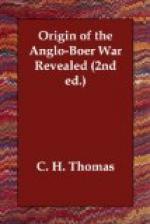In about 1893 the Transvaal Government introduced about 10,000 new rifles of the Guede pattern, firing a steel-pointed bullet, but the issue did not become general, as the Martini-Henry rifle continued to be held more effective for game and for war. The Mauser rifle was only provided, after long hesitation and much diffidence, for its rapid-firing quality in war, whereas for game it is still considered inferior to the larger bored Martini-Henry.
On the occasion of the Jameson incursion, the Transvaal had in readiness extensive parks of the most modern quick-firing Maxims and Nordenfeldts of various calibres, and breech-loading field artillery of the Krupp make. The Orange Free State hurried to their assistance with similar artillery, each burgher armed with a Martini-Henry rifle. Besides all that, there was the dynamite and explosives factory equipped to manufacture all sorts of modern ammunition as it does now, and this is why President Krueger described that factory as one of the corner-stones of Boer independence. In the face of these facts it is a most singular departure to say that the Transvaal only thought of arming when becoming alarmed for the future by the Jameson attempt, and that statement could only have been intended to mislead the uninformed at a distance. “Qui s’excuse s’accuse” is applicable in this as well as in other ruses for hiding those sinister Bond aims and to pose as the guileless and victimized Boer nation. It was just the other way about—it was England who was unprepared and exposed to imminent risk of aggression on the part of the Boer combination.
What had amazed and actually exasperated many Boers was the ludicrously puny attempt made by Jameson and the Johannesburg revolutionary concert. It was at the time thought that the invasion of some 700 men was only a first installment, and that much larger developments were in preparation to attack the State. It was for that reason that only a few batteries of artillery were despatched at a late moment to Doornkop under Commandant Trichaart to operate against Jameson’s party, while the bulk was held in reserve with an extensive mobilization of burghers to resist other supposed opposition of an altogether more formidable but yet undefined character. When nothing further transpired, the feeling uppermost with the people was unbounded derision at that impotent fiasco, and a loathing contempt for the cowering Johannesburg




